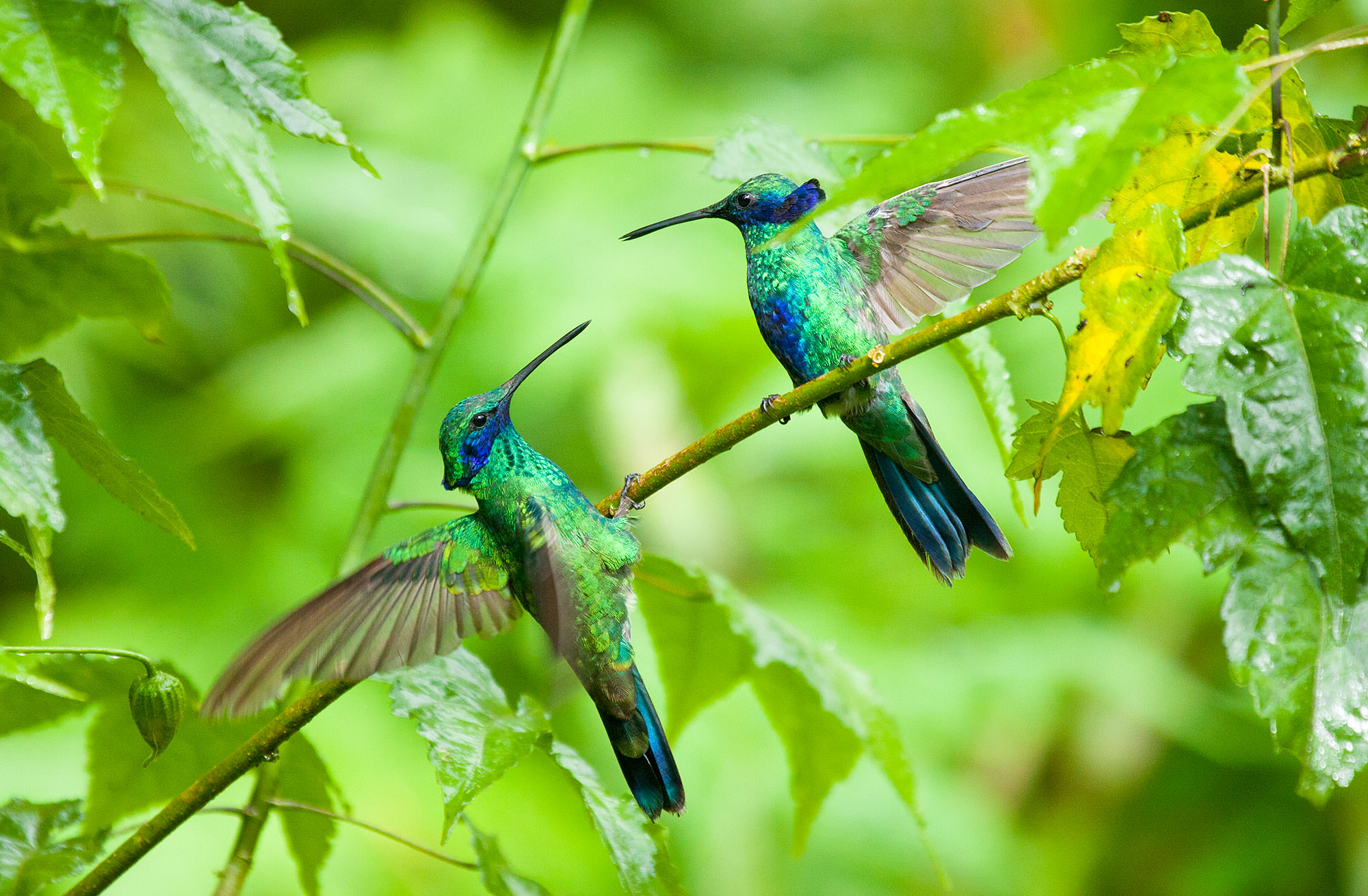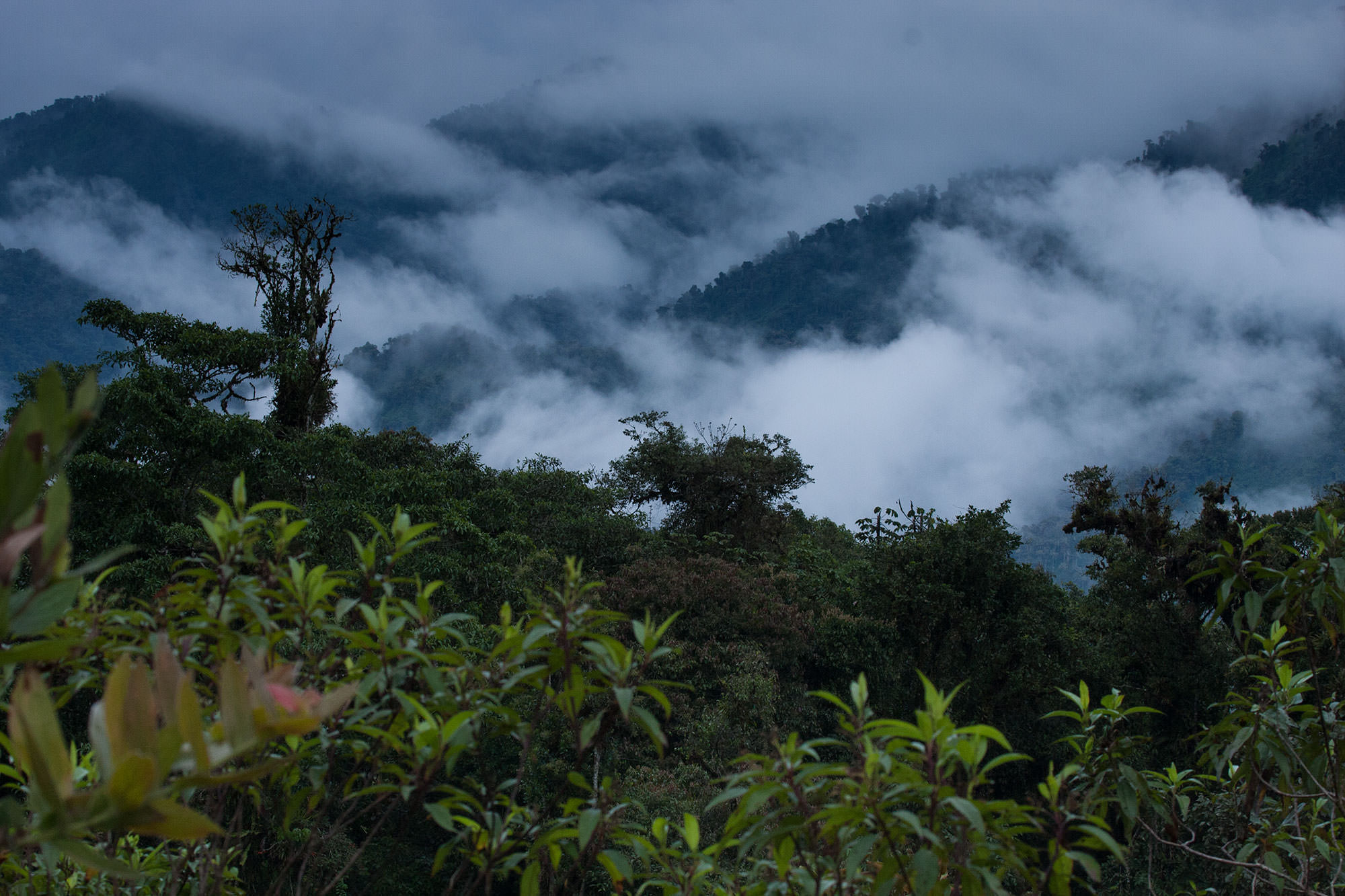Neotropics

The Sylph in the Forest
Notes on the ethereal denizens of th Eastern slope of the Andes as well as the importance of the diverse habitats of the Andean slopes.
Above: Sparkling Violetears (Colibri coruscans) on the Eastern Slope of the Andes in Ecuador.
The Andes are so high, and so long, and such a profound component of South America – like a backbone for a continent - that much in Ecuador seems to depend on which slope you happen to be on. Cuisine seems to change by elevation. Culture is determined by elevation too. And the biological world in particular seems to be ruled by the slopes.
“I notice you are always referring to the Eastern and Western slope,” I ask Gabriel, “so that’s how they refer to things all up and down the Andes?”
“No, not at all,” he says. “It’s much more complex than that, so it depends where you are.”
From Quito, we drive southeast on a modern road towards the Papallacta Pass, where the road begins to slope downwards towards the flat Amazon Basin. At the top, we veer off into the Cayambe-Coca Reserve via a dirt road and ascend to an elevation of 14,000 feet. Gabriel parks his truck next to a series of cell phone antennas. The security guard for the antennas joins us, and we walk uphill on a small stone path. From the top, we can see mountains in every direction.
The landscape here looks like a coral reef on land, and also like an alpine swamp. Its called Páramo, and as an ecosystem, it exists only here in the Northern Andes. Windswept, barren, rocky, but not devoid of life.

Guango River, near the Papallacta Pass
While the three of us talk, looking out over the landscape, a pair of Andean Condors appear from below us, gliding on currents of air toward us. Seeing these birds here is an accident – there are less than a hundred of them in Ecuador, perhaps as few as thirty. Their wingspans, which reach over ten feet, make them the largest flying birds in the world. They sail right for us, and for just a few brief seconds, these giant vultures pass right over us. It is an awesome sight, even for Gabriel and the security guard.
In Europe, Africa and Asia, vultures are bald-headed, with black overcoats and a mean grimace. In the America’s, vultures are bald-headed, with black overcoats, and a menacing grimace. This is entirely coincidental. In the old world, vultures are just scavenging raptors. America’s vultures, are the scavenging descendents of storks. How can such an apparently barren land feed such a giant animal? Perhaps because the highlands of the Andes is to cold to sustain the various agents of decomposition. The Andean condor is virtually alone in a quest for dead flesh.
While the high elevations of the Northern Andes feeds the largest of the flying birds, it also makes a fine place to feed the smallest of the flying birds. In the evening, we descend and head east, to a small lodge. Already, here, the lower elevation – about 9,500 feet, means the environment has changed entirely. No longer paramo, but humid tropical forest, dense, lush, green.

Details of the unusual vegetation typical in Paramo ecosystems.
Dinner at Guango Lodge is lovely. You could say that dinner here may be superior to some of the finest New York City restaurant dinners, and yet, there will be no bill tonight for the meal. This is the paradox of traveling from small lodge to small lodge in Latin America, where meals are often included, and dinner is prepared not by a renowned chef, but by somebody’s mother.
Guango Lodge is a very specialized lodge. It caters to hummingbird enthusiasts who want to see species adapted to the high elevations of the Eastern Slope of the Andes, a thin band of humid temperate forest that happens to house some of the strangest, most elegant and delicate hummingbirds of Ecuador.
As the kitchen prepares a cilantro soup for Gabriel and I, two men wearing clothes the color of old computer equipment walk through the lodge door. They have a tremendous amount of photography equipment strapped to them. They both look relieved when they settle their telephoto lenses and tripods in the corner.
Jim and Alejandro didn’t know each other until a few days ago, but they have something very important in common, despite the fact that one hails from Central California and the other Barcelona – they love to photograph birds, and in particular, they love to photograph hummingbirds.
Gabriel and I are interested in their itinerary, and when I tell Jim that I would love to see his hummingbird photos, he lights up, and we agree to look through them after dinner.
The manager brings us a fruit juice just made fresh from the kitchen. It is a refreshing and crisp juice made from guanadilla, passionfruit and other fruits and vegetables from nearby elevations.
After dinner, Jim sits down next to Gabriel and I, and turns on his digital camera. Immediately, I am horrified and curse myself silently for my amateur mistake. Jim’s digital photo counter shows that he has 1,800 photos on his memory card.

Leaf Hopper sp. near Papallacta
The majority of his photos are hummingbirds from the western slope of the Andes, as the small hummingbird workshop group he is with has spent the last week at a series of lodges on that side of the Andes.
Gabriel is a naturalist and bird guide who specializes in all of Ecuador, rather than on a particular region, and so he is quite happy to share with Jim his opinions about the many species Jim has photographed. And Gabriel’s transcriptions make the first 30 or so photos enjoyable.
Jim, meanwhile, comes to a photo of a Velvet-purple Coronet and he says, “just look at the gorget on that fella. The way it shines!”
He turns the dial to the next photo, which was photographed no more than half a second before the last image. “Now this photo really captures this beauty. You see how he is looking right at the camera?” He turns the dial again. “Just look at those coverts!”
Gabriel, looking tired, excuses himself, and I ask the kitchen for a beer. They bring me a beer and as well as a native Ecuadorian drink – sweet, ‘but more alcoholic than it tastes.”

Minerals soak the shore of the Guango River with color.
In the morning, Gabriel and I explore the area by foot, walking on paths through the forest. This area, at about 9,800 feet, is indeed tropical, and because it sits on the high Andes, there are many steep slopes covered in canopies of green. But like the treeless landscape at 14,000 feet, the area around Papallacta isn’t what you might associate with tropical latitudes. It is cool here, and although the plants are exotic and tropical, there is something about this area that reminds me of the mountains of the Pacific Northwest.
In this cool tropical landscape, animals appear to be absent. But they are indeed everywhere, and I am shocked by Gabriel’s ability to pick out a small animal as far as a football-field length away. Without the aid of a binoculars, he identifies a hummingbird on the other side of a steep valley. To me, its just another tiny twig in a universe of twigs and branches and flowers and air plants. How does he see this tiny, nearly invisible bird perched nearly a quarter mile away?
Hummingbirds exist only in the new world, but they are far from evenly distributed. Of the 340 species (hummingbird species comprise almost three-and-a-half percent of all bird species), only a handful live in the temperate New World – the United States and Canada, on one end, and Chile on the other. In fact, the greatest diversity is found in the Northern Andes, specifically here in Ecuador and along the spines of the Andes, in Columbia.
The speciation of the hummingbirds is astounding. But why so many here in the Andes? Hummingbirds are seen as high as 17,000 feet, darting along the ground beneath the condors. And the amount of species even in the high altitudes is also astounding. In North America, typically, as you ascend in elevation or move into colder climates, diversity drops.
The answer is related to why the condor can thrive in such conditions. Condors, as scavengers, can feed their gigantic bodies because the colder weather means a relative absence of insects to quickly decompose carrion. But an absence of insects also means an absence of traditional pollinators for the flowers.

A Long-tailed Sylph Hummingbird at San Isidro
The slopes of the Andes themselves, which create so many distinct ecologies, and which effectively isolate so many plants and animals from each other, create one of the conditions for the wide variety of hummingbirds. Many of the flowering plants of the Andes have actually co-evolved along with the hummingbirds upon which each mutually rely on. So, slopes and flowers and elevation make for forests of incredible hummingbirds. Sword-billed hummingbirds, whose bill is longer than the rest of its body, plunge into long-necked passionflowers. Seeing that bird is to see the extremes of co-evolution. The plant and the bird need to make each other dependent on the other, so their fates are entertwined.
One hummingbird genus in the Andes is like nothing else in nature, and probably one of nature’s most spectacular. They are aptly-named the Sylphs, after the invisible elementals of mythology. Here in Ecuador’s montane forests, the male Long-tailed Sylph has a tail so incredibly long – several lengths of the bird’s body – that it actually makes flight difficult for itself.
The tail, so long, is also of a complex turquoise-cerulean hue. To see one in flight is to witness something that seems as if it weren’t meant to be.
Because sylphs are so conspicuous in their bright shades of green, blue and violet, they are also skittish, and rarely spend more than a few seconds in any one location. And while the surreal colors of hummingbirds – designed to attract mates – seems dangerous in a world where other animals bent on eating hummingbird, those flashes of color are actually surprisingly good at cloaking the bird in the shades of the forest.
After two days walking in these high-elevation forests, I too began to realize that we are capable of locating these tiny animals in the dense, complex forests. You learn that a certain type of hummingbird has a certain way of perching, and prefers a certain type of place. If man is a species that evolved to find patterns in nature in order to find food, then something just clicked when I looked over the valley through the fog and rain, and on the other side of the valley, I just knew a long-tailed sylph would be sitting there. And he was.
